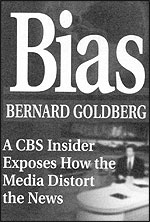
Bias: A CBS Insider Exposes How the Media Distort the News
Bernard Goldberg
Regnery Publishing. 234 Pages. $27.95.
There aren’t many people who pick up “Bias” without a preconception about the book’s major theme: that a pervasive liberal tilt in the news business shows up in the daily news coverage. From my vantage point as a long-time newspaper reporter and editor, I think former CBS correspondent Bernard Goldberg’s contention is correct, in a general sense, although I can’t speak about CBS specifically since I never worked there. The nation’s newsrooms are more often than not staffed with reporters and editors whose stories and their placement reflect a mindset that fairly could be described as liberal. In fact, I discovered as I read the book that, to buttress his case, Goldberg quotes a study I did in 1993-94 with a professional pollster in which we surveyed journalists and people who live in their market areas about their values and lifestyles, and we reported on the large differences we found.
There are two main themes to Goldberg’s book. There is his ideological argument that is threaded throughout “Bias,” and then there is the story of what Goldberg says happened to him at CBS News once he began voicing his views about a liberal bias. In that section, he spends a great deal of time discussing CBS News anchor Dan Rather’s personal and professional flaws. In the book, Goldberg criticizes Rather for his alleged two-faced behavior and being unable to recognize and deal with his own bias. This criticism of Rather gives “Bias” a celebrity appeal that might, in part, explain why it rose to number one on national bestseller lists.
But it would be foolish—especially for journalists—to ignore the chord that “Bias” has struck with a significant portion of the book-reading public and, I’d argue, with the population in general. After all, public opinion polls show that journalists compete with members of Congress when it comes to their low ranking in public esteem. Other polls indicate that more Americans ascribe a liberal bias to the media than they do a conservative one. Interestingly, during January, for the first time Fox News Channel (often derided by those in the news business for its “conservative slant”) topped both CNN and MSNBC in viewership, though it is available in millions fewer homes.
Although Goldberg wasn’t aware of Fox News Channel’s ratings coup when he wrote the book, its success enhances his argument. Fox News Channel’s Roger Ailes bristles at critics’ claims that his network has a conservative slant: “The TV industry in New York believes that if a conservative gets to give his point of view, that’s bias,” Ailes observes.
What Goldberg drives home in “Bias” is his contention that most newsroom staffers share a similar left-of-center mindset. However, he is also quick to point out that this liberal bias is not widely evidenced in the news media’s reporting on political campaigns or parties: The news media, Goldberg observes, are not tougher on Republicans than Democrats. In fact, this aspect of coverage is the most misunderstood part of the traditional argument regarding bias in the media. Certainly, examples of slanted coverage can be unearthed. And virtually every study of journalists’ political leanings and voting behavior shows they are much, much more likely to be Democrats than are members of the general population. But these demographic findings don’t get translated into charges of widespread bias. Even those who dispute the liberal-bias-in-politics argument don’t quarrel with the data: Their argument is that journalists ignore their own political biases to present balanced stories.
Goldberg does not dwell long on the debate over bias and political coverage. Instead, he offers a more profound argument that even those who dispute the “bias” charge should consider because it emerges from the demographics of who chooses to work in the news business. “The old argument that the network and other ‘media elites’ have a liberal bias is so blatantly true that it is hardly worth discussing anymore,” Goldberg wrote in a Wall Street Journal op-ed that led to his writing this book. “No, we don’t sit around in dark corners and plan strategies on how we are going to slant the news. We don’t have to. It comes naturally to most reporters.”
In “Bias,” Goldberg makes the case that the media’s tilt is not the product of a left-wing conspiracy but the result of like-minded people being attracted to the same profession and reinforcing their existing views and values. As they gain stature, the work that consumes their daily lives does not bring them into much contact with average Americans. Nor do they live in the same neighborhoods, nor socialize with, nor have conversations with “Joe and Jill Six-pack.”
As this separation grows larger, journalists develop unanimity of thought, which is out of sync with many who comprise their audience. Goldberg argues that these circumstances are what lead to the bias problem because in American newsrooms there develops a perceived way in which reporters look at certain issues—especially social ones. Data from a variety of studies (including mine) find that journalists overwhelmingly favor gay and abortion rights, affirmative action, and subscribe to the general view that government (not the private sector) is best equipped to solve social problems. In the general population one finds a greater division of views on these issues.
Goldberg uses homelessness and AIDS to illustrate the practical effect this perspective has in influencing news coverage of certain issues. News stories about these topics, Goldberg argues, contain healthy doses of what The New York Times TV critic Walter Goodman called “the prettifying of reality.” Goldberg notes that people in news stores about homelessness or AIDS were more often shown to be white and middle class and were portrayed as victims, regardless of their personal behavior.
Goldberg contends that the reporters’ effort to select as subjects those people who were more mainstream than the actual AIDS patient or homeless person fit the agenda of advocates, who use this reporting to elicit public sympathy for their cause and tax dollars for their programs. He contends that within newsrooms this politically correct mindset led reporters and editors to support—through their news coverage—the perspectives and arguments of these homeless and AIDS advocates. Not coincidentally, this idea that these things were happening to a large degree in middle-class suburbia made more arresting news stories.
The problem is that the data on who was homeless and who got AIDS were in conflict with the media’s picture. Studies have consistently shown that the vast majority of AIDS patients are IV drug users or sexual partners of homosexuals; they are not the white, freckle-faced, middle-class teenage girl exposed to HIV in her first sexual experience. The homeless were heavily male, in many cases mentally ill and former convicts, not single mothers with three cute kids.
Goldberg cites the following statistical comparisons to underscore his point. The Washington, D.C.-based Center for Media and Public Affairs studied network news stories during 1992 and found that six percent of AIDS victims shown on the networks’ evening news programs were gay men compared with government figures showing that 58 percent of the U.S. AIDS population was comprised of gay men. (In 1999, the Centers for Disease Control and Prevention reported that about 14 percent of AIDS victims contracted the disease through heterosexual contact.) Only two percent of the victims shown in televised news coverage were IV drug users, yet among AIDS patients, 23 percent used IV drugs. On TV, 16 percent of victims were black or Hispanic, compared to 46 percent nationally.
Goldberg makes the valid point that most journalists would not take information from a conservative group and report it without checking it thoroughly. But when they receive information from liberal advocates, journalists do not apply the same scrutiny because their natural predisposition prepares them to accept the perspective they are being told.
Few who work in America’s newsrooms are open-minded about Goldberg’s argument. Many have derided his thesis and disputed his evidence. But by instigating discussion about media bias, Goldberg has prompted the emergence of an important dialogue that had long been simmering beneath the surface. And if one assumes, if only for the sake of having this discussion, that Goldberg is correct—that like-minded people from similar backgrounds disproportionately inhabit newsrooms and that unanimity creates bias in the coverage—then a more pressing question is what can or should be done about it?
Goldberg doesn’t offer prescriptive solutions in this book, and proposing what those might be is very difficult since seriously addressing this set of circumstances would require a major reexamination of how the news business operates.
Don’t bet on it happening any time soon. Unfortunately.
Peter A. Brown, a 1982 Nieman Fellow, is editor of the Insight section and an editorial columnist for the Orlando Sentinel.



